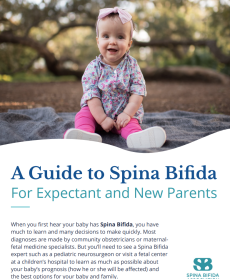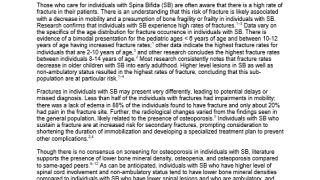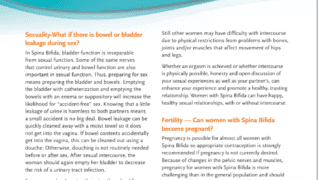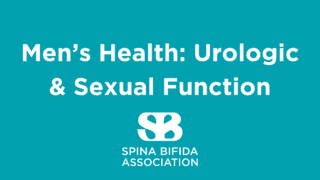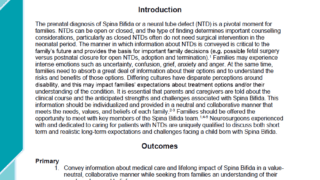This resource contains information for parents who have received a diagnosis or parents who have recently had a baby with Spina Bifida.
When you first hear your baby has Spina Bifida, you have much to learn and many decisions to make quickly. Most diagnoses are made by community obstetricians or maternal-fetal medicine specialists. But you’ll need to see a Spina Bifida expert such as a pediatric neurosurgeon or visit a fetal center at a children’s hospital to learn as much as possible about your baby’s prognosis (how he or she will be affected) and the best options for your baby and family.
What is Spina Bifida?
Spina Bifida happens when a baby’s growing spine (neural tube) does not fully close during the first few weeks of pregnancy. Each case is different, and the effects of Spina Bifida vary based on the size, location, type of opening, and the exact nerves affected.
The most common type of Spina Bifida diagnosed during pregnancy is myelomeningocele (my-low-ma- NIN-go-seal). This is called an “open” form of Spina Bifida because there is an opening in the skin over a sac of fluid containing part of the spinal cord and nerves. That opening needs to be closed with surgery to protect the spinal cord from infection and more damage. When people talk about Spina Bifida, they are usually talking about myelomeningocele.
There are also less common types of Spina Bifida that are closed (covered by skin) but the spinal cord is still affected. These usually need treatment but not always immediately.
Spina Bifida Occulta is sometimes called “hidden” Spina Bifida. There is a small gap in the bones of the spine, but it is also covered by skin and the spinal cord is usually not involved. This type is rarely found prenatally and often needs no treatment.
What causes Spina Bifida?
Spina Bifida can happen no matter what parents do before or during pregnancy. A baby’s growth is a complicated process with many chances for variations. Disability is a natural form of diversity that has been present throughout human history. Spina Bifida happens because of a mix of genetic and environmental factors around the fourth week of pregnancy—before most women even know they are pregnant. There is still much for researchers to learn about the genetics associated with Spina Bifida. Taking folic acid (included in most multivitamins and prenatal vitamins) for one to three months before conception may help reduce the chance of Spina Bifida, but it is not entirely preventable. It was not caused by anything you did or did not do.
How is Spina Bifida diagnosed during pregnancy?
A routine Maternal Serum Alpha-Fetoprotein (AFP) blood test performed between the 15th-20th weeks of pregnancy can show a greater possibility of neural tube defects such as Spina Bifida.
Diagnosis is usually made during an ultrasound with spine markers such as missing vertebrae (back bones) or pieces of vertebrae; and/or brain markers such as ventriculomegaly (enlarged ventricles), a specific fetal skull shape (the “lemon sign”), and crowding of the cerebellum (the “banana sign”).
Sometimes doctors do an amniocentesis test, which takes a small amount of fluid from around the baby in the uterus. The fluid is tested to see if it contains cerebrospinal fluid (CSF), which is the liquid that surrounds the baby’s brain and spine. If it does, that tells us the baby’s back is “open” instead of covered by skin. The fluid can also be tested for other genetic conditions.
A fetal MRI may be used to better see the size, location, and details of the lesion.
What is life like with Spina Bifida?
Each person with Spina Bifida is different. Just as with any child, it is impossible to fully predict someone’s physical and medical outcome before or at birth. Some may have significant disabilities and others may be less affected. Medical advancements over the past 70 years have improved health, life expectancy, and quality of life. And cultural attitudes toward people with disabilities have changed and continue to change, resulting in improved services, inclusion, and acceptance.
Parents may be told at diagnosis that their child will have a poor quality of life, but there is no evidence to support this. Research shows that teens and adults with Spina Bifida overwhelmingly describe their quality of life as “good” or “very good.”
Just like everyone else, people with Spina Bifida have different interests, personalities, ambitions, and talents. Parents can help their children with Spina Bifida live full lives by encouraging independence, making sure they have good medical care, and finding support from the Spina Bifida community. Many people with Spina Bifida earn advanced education, have careers, build families of their own, travel, play sports, play instruments, find meaningful hobbies, crack jokes, have fun, and add tremendous value to their communities. Spina Bifida influences their lives but does not define them.
The Spina Bifida community is a place of support, understanding, and acceptance. Your team of healthcare providers, therapists, and teachers become like family along the way. And connecting with other families can help both you and your child feel seen and understood. In addition to the national Spina Bifida Association, there are many local chapters and support groups across the country. Online groups also provide connections with other parents of children with Spina Bifida and adults who have grown up with the condition.
How does Spina Bifida affect people?
No two cases of Spina Bifida are the same, but there are some common issues. The good news is there are treatment options to help your child reach their unique potential.
- Lifespan Outlook – Advancements in healthcare have greatly increased the length and quality of life for people with Spina Bifida. Babies born with Spina Bifida today are typically expected to live long lives. Many factors affect life expectancy, such as other conditions the baby may be born with, and the healthcare they receive throughout life. Spina Bifida itself is not a condition that causes active physical decline, but its effects on the body can change with growth and secondary health issues.
- Learning Abilities – People with Spina Bifida span a wide range of intellectual abilities, just as in the general population. They may have challenges with math or executive functioning skills like attention and organization. Developmental pediatricians and neuropsychologists help parents and teachers understand how each child learns best and how to help with the challenges.
- Hydrocephalus – When the spinal cord gets pulled into the sac on the baby’s back, it can tug on the cerebellum (the part of the brain at the back of the head near where the spinal cord connects to the brain) to narrow the path for the CSF to flow between the brain and spine. CSF may begin to build up in the ventricles (pockets of fluid in the brain that are normally present) and make them larger—this is called ventriculomegaly. Babies’ heads are very flexible and can hold some extra fluid, but too much can cause pressure in the brain, known as hydrocephalus. This is a very common condition with the open type of Spina Bifida, but is also very treatable. There are two main treatments to help the brain reroute extra fluid so it can continue growing well. A shunt is a tube that directs CSF to the abdomen (or other area of the body). And an ETV (endoscopic third ventriculostomy) is a surgery that creates an extra opening in the brain to allow more fluid to drain. Sometimes with an ETV, a baby also needs a CPC (choroid plexus cauterization) to decrease how much fluid the brain makes. A neurosurgeon can help you decide which option is best for your baby.
- Neurogenic Bowel and Bladder – Damage to the lower spinal nerves also causes different levels of problems with bowel and bladder function. Everyone is affected differently, but there are many treatments to keep the bladder and bowel healthy, improve continence (staying dry and clean) when age appropriate, and allow a child independence with self-care. Urologists and gastroenterologists monitor and treat these conditions.
- Mobility – Because Spina Bifida affects nerves to the lower part of the body, it often causes leg weakness. Many children are able to walk—with or without supports such as leg braces, walkers, or crutches. Some are full-time walkers, some walk short distances and choose a wheelchair for long distances, and those with openings higher on the spine may mostly use a wheelchair for mobility. A team of specialists including an orthopedist, physical therapist, orthotist, and others can help you figure out how to get your baby moving.
- Independence – Most people with Spina Bifida can become independent with their own care with training and encouragement. Over time, you will build a team of doctors, nurses, social workers, teachers, support organizations, and other families to support you and your child on this journey. Working together can often lead to good outcomes in independent living, employment, and other measures of quality of life. Being independent does not necessarily mean not needing support. As a society, we all help each other. We rely on farmers and grocers for food, hair stylists, mechanics, and many others. What most of us mean by independence is having a choice in what we do and how we live. This is something parents can help children with Spina Bifida achieve no matter their physical ability.
What are the choices for parents expecting babies with Spina Bifida?
It is very important to meet with providers who specialize in Spina Bifida so you know all options that are available and appropriate for you and your baby.
- Prenatal closure – Some hospitals offer fetal surgery to close the baby’s back while you are still pregnant, before 26 weeks gestation. Research shows this type of closure can reduce the risk of needing a shunt for hydrocephalus and increase the odds of walking independently. Not everyone is a candidate for fetal surgery, and there are several risks, including surgical complications for the mother and a high rate of preterm birth. A fetal surgery evaluation at a hospital that performs the surgery will help you decide whether you and your baby qualify and if it is the best choice for you.
- Postnatal closure – Another treatment for babies with Spina Bifida is surgery to close the opening in the spine within 72 hours after birth. Talk to your obstetrician and the baby’s neurosurgeon about whether cesarean section or vaginal delivery is best for you and baby with this option.
- Other Options You may also talk to your providers about other options, including adoption and termination, and services and support for those choices.
Care after birth
Whether the baby has prenatal or postnatal closure, most will be monitored in the neonatal intensive care unit (NICU) after birth. The length of stay varies based on the baby’s particular needs.
After the baby is discharged from the hospital, he or she will need regular follow-up appointments with a pediatric neurosurgeon, orthopedist, urologist, and other specialists as needed, such as a gastroenterologist and developmental pediatrician. You may choose for these visits to be coordinated and scheduled together through a Spina Bifida clinic or spread out with individual providers. A list of clinics may be found at spinabifidaassociation.org/clinics. Appointments will be frequent at first and less often as time passes. Good care throughout the lifetime will increase both health and quality of life.
Your state’s early intervention program will be another resource to support your baby and family with physical, occupational, and developmental therapies, among others.
This information does not constitute medical advice for any individual. As special cases may vary from the general information presented here, SBA advises readers to consult a qualified medical or other professional on an individual basis.
Resources
I’m interested in resources related to:
Tags
